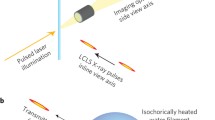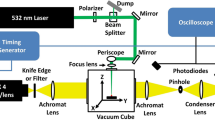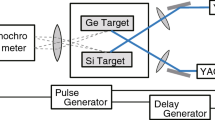Abstract
We present observations from an experimental study of the ablation of a free liquid surface promoted by a focused laser pulse, causing a rapid discharge of liquid in the form of a very thin conical-shaped sheet. In order to capture the dynamics, we employ a state-of-the-art ultra-high-speed video camera capable of capturing events at \(5 \times 10^{6}\) fps with shutter speeds down to 20 ns, whereby we were able to capture not only the ejecta sheet, but also the shock wave, emerging at speeds of up to 1.75 km/s, which is thus found to be hypersonic (Mach 5). Experiments were performed at a range of ambient pressures in order to study the effect of air drag on the evolution of the sheet, which was always observed to dome over, even at pressures as low as 3.8 kPa. At reduced pressures, the extended sheet evolution led to the formation of interference fringe patterns from which, by comparison with the opening speed of rupture, we were able to determine the ejecta thickness.










Similar content being viewed by others
References
Apitz I, Vogel A (2005) Material ejection in nanosecond Er:YAG laser ablation of water, liver, and skin. Appl Phys A 81:329–338
Aristoff JM, Bush JWM (2009) Water entry of small hydrophobic spheres. J Fluid Mech 619:45–78
Armstrong RL (1984) Aerosol heating and vaporization by pulsed light beams. Appl Opt 23:148–155
Bird JC, de Ruiter R, Courbin L, Stone HA (2010) Daughter bubble cascades produced by folding of ruptured thin films. Nature 465:759–762
Carls JC, Brock JR (1988) Propagation of laser breakdown and detonation waves in transparent droplets. Opt Lett 13:273–275
Chen RCC, Yu YT, Su KW, Chen JF, Chen YF (2013) Exploration of water jet generated by Q-switched laser induced water breakdown with different depths beneath a flat free surface. Opt Express 21:445–453
Chitanvis SM (1986) Explosion of water droplets. Appl Opt 25:1837–1839
Choo YJ, Kang BS (2001) Parametric study on impinging-jet liquid sheet thickness distribution using an interferometric method. Exp Fluids 31:56–62
de Ruiter J, MUgele F, van den Ende D (2015) Air cushioning in droplet impact I. Dynamics of thin films studied by dual wavelength reflection interference microscopy. Phys Fluids 27:012104
de Ruiter J, MUgele F, van den Ende D (2015) Air cushioning in droplet impact II. Experimental characterization of the air film evolution. Phys Fluids 27:012105
Eickmans JH, Hsieh W-F, Chang RK (1987) Laser-induced explosion of H2O droplets: spatially resolved spectra. Opt Lett 12:22–24
Gillbarg D, Anderson R (1948) Influence of atmospheric pressure on the phenomena accompanying the entry of spheres into water. J Appl Phys 19:127–139
Heijnen L, Quinto-Su PA, Zhao X, Ohl C-D (2009) Cavitation within a droplet. Phys Fluids 21:091102
Hsieh W-F, Zheng J-B, Wood CF, Chu BT, Chang RK (1987) Propagation velocity of laser-induced plasma inside and outside a transparent droplet. Opt Lett 12:576–578
Kafalas P, Herrmann J (1973) Dynamics and energetics of the explosive vaporization of fog droplets by a 10.6-μm laser pulse. Appl Opt 12:772–775
Lee M, Longoria RG, Wilson DE (1997) Cavity dynamics in high-speed water entry. Phys Fluids 9:540–550
Lhuissier H, Villermaux E (2012) Bursting bubble aerosols. J Fluid Mech 696:5–44
Lindinger A, Hagen J, Socaciu LD, Bernhardt TM, Woste L, Duft D, Leisner T (2004) Time-resolved explosion dynamics of H2O droplets induced by femtosecond laser pulses. Appl Opt 43:5263
Marston JO, Thoroddsen ST (2015) 2015 Laser-induced micro-jetting from armored droplets. Exp Fluids 56:140
Marston JO, Mansoor MM, Truscott TT, Thoroddsen ST (2015) Buckling instability of crown sealing. Phys Fluids 27:091112
May A (1952) Vertical entry of missiles into water. J Appl Phys 22:1362–1372
Savva N, Bush JWM (2009) Viscous sheet retraction. J Fluid Mech 626:211–240
Tagawa Y, Oudalov N, Visser CW, Peters IR, van der Meer D, Sun C, Prosperetti A, Lohse D (2012) Highly focused supersonic microjets. Phys Rev X 2:031002
Thoraval M-J, Takehara K, Etoh TG, Popinet S, Ray P, Josserand C, Zaleski S, Thoroddsen ST (2012) von Karman vortex street within an impacting drop. Phys Rev Lett 108:264506
Thoroddsen ST, Takehara K, Etoh TG, Ohl C-D (2009) Spray and microjets produced by focusing a laser pulse into a hemispherical drop. Phys Fluids 21:112101
Thoroddsen ST, Thoraval M-J, Takehara K, Etoh TG (2011) Droplet splashing by a slingshot mechanism. Phys Rev Lett 106:034501
Villermaux E (2007) Fragmentation. Annu Rev Fluid Mech 39:419–446
Zhiyuan Z, Hua G, Zhenjun F, Jie X (2014) Characteristics of droplets ejected from liquid propellants ablated by laser pulses in laser plasma propulsion. Plasma Sci Technol 16:251–254
Acknowledgments
The research was partially funded by KAUST Office of Competitive Research Funds. The authors thank Jesse Belden for assistance with the interferometry calculations.
Author information
Authors and Affiliations
Corresponding author
Electronic supplementary material
Below is the link to the electronic supplementary material.
Rights and permissions
About this article
Cite this article
Marston, J.O., Mansoor, M.M., Thoroddsen, S.T. et al. The effect of ambient pressure on ejecta sheets from free-surface ablation. Exp Fluids 57, 61 (2016). https://doi.org/10.1007/s00348-016-2141-9
Received:
Revised:
Accepted:
Published:
DOI: https://doi.org/10.1007/s00348-016-2141-9




